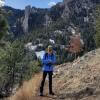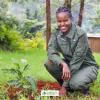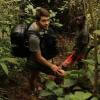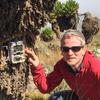Camera traps have been a key part of the conservation toolkit for decades. Remotely triggered video or still cameras allow researchers and managers to monitor cryptic species, survey populations, and support enforcement responses by documenting illegal activities. Increasingly, machine learning is being implemented to automate the processing of data generated by camera traps.
A recent study published showed that, despite being well-established and widely used tools in conservation, progress in the development of camera traps has plateaued since the emergence of the modern model in the mid-2000s, leaving users struggling with many of the same issues they faced a decade ago. That manufacturer ratings have not improved over time, despite technological advancements, demonstrates the need for a new generation of innovative conservation camera traps. Join this group and explore existing efforts, established needs, and what next-generation camera traps might look like - including the integration of AI for data processing through initiatives like Wildlife Insights and Wild Me.
Group Highlights:
Our past Tech Tutors seasons featured multiple episodes for experienced and new camera trappers. How Do I Repair My Camera Traps? featured WILDLABS members Laure Joanny, Alistair Stewart, and Rob Appleby and featured many troubleshooting and DIY resources for common issues.
For camera trap users looking to incorporate machine learning into the data analysis process, Sara Beery's How do I get started using machine learning for my camera traps? is an incredible resource discussing the user-friendly tool MegaDetector.
And for those who are new to camera trapping, Marcella Kelly's How do I choose the right camera trap(s) based on interests, goals, and species? will help you make important decisions based on factors like species, environment, power, durability, and more.
Finally, for an in-depth conversation on camera trap hardware and software, check out the Camera Traps Virtual Meetup featuring Sara Beery, Roland Kays, and Sam Seccombe.
And while you're here, be sure to stop by the camera trap community's collaborative troubleshooting data bank, where we're compiling common problems with the goal of creating a consistent place to exchange tips and tricks!
Header photo: Stephanie O'Donnell
No showcases have been added to this group yet.
Cummings School of Veterinary Medicine at Tufts University
Wildlife veterinarian & professor in Conservation Medicine
- 0 Resources
- 5 Discussions
- 1 Groups
- @NevilleCLS
- | He/Him
CLS (Collecte Localisation Satellites)

- 0 Resources
- 1 Discussions
- 14 Groups
I am a biology undergraduate student who is interested in the field of wildlife conservation and has skills in field observation and identification
- 0 Resources
- 0 Discussions
- 12 Groups
- @WCBHP
- | He, him
Retired, living on South Africas Northern west coast tracking Brown hyena
- 0 Resources
- 0 Discussions
- 2 Groups
- @Meagan
- | she/her
Supporting wildlife monitoring in remote Pacific Islands
- 0 Resources
- 1 Discussions
- 3 Groups
Terrestrial Ecologist
- 0 Resources
- 1 Discussions
- 4 Groups
- 0 Resources
- 1 Discussions
- 2 Groups
Consejo Nacional de Investigaciones Científicas y Técnicas
- 0 Resources
- 5 Discussions
- 3 Groups
- @marinejoly
- | she / her
Associate Professor in Cognitive Ethology (University of Portsmouth, UK), I am interested in primate behaviour and cognition. I am seeking new avenues to investigate animal cognition and address conservation issues.
- 0 Resources
- 0 Discussions
- 5 Groups
- @kbubnicki
- | he/his
Ecologist, data scientist, and programmer with over 13 years of professional experience. Open source and Linux enthusiast. Researcher at the Mammal Research Institute, Polish Academy of Sciences, and CEO of the Open Science Conservation Fund.

- 0 Resources
- 5 Discussions
- 5 Groups
- 0 Resources
- 5 Discussions
- 8 Groups
- @mdorigo
- | she/her
- 0 Resources
- 0 Discussions
- 3 Groups
Article
There is a revolution coming in conservation. Advances in conservation technology are generating more data than ever before on what lives where, who eats who, and what’s disappearing and how fast, but it still requires...
10 May 2017
In this From the Field interview, we speak to Dr. Raman Sukumar, a world renowned expert on Asian elephant conservation. He shares his thoughts on how technology could be used for mitigating elephant-human conflict, and...
5 April 2017
The Camera Traps group is one the most active in our community, with members keen to discuss approaches to data management and processing, study design, and new software and hardware developments. Indeed, the top entry...
23 March 2017
Are you ready for this year's #Tech4Wildlife Photo Challenge? In anticipation, we're counting down our ten favourite entries from last year. Do you think you can top these?
1 March 2017
The Conservation Leadership Programme (CLP) is a training and capacity building programme that targets individuals from developing countries who are early in their conservation career and demonstrate leadership...
21 November 2016
Do you work on conserving Neotropical migratory birds? Do you need funding? Why not apply for a grant from the U.S. Fish and Wildlife Service through the Neotropical Migratory Bird Conservation Act's grant program? The...
8 November 2016
Article
The internet has a long love affair with cat pictures, but these aren’t your mom’s internet cats. Now internet cats are getting even bigger and wilder. In this article, Dr. Lisa Feldkamp talks about the work Panthera is...
26 October 2016
Caves don't tend to be well-liked ecosystems, being extremely dark, often quite cramped, and slippery. And the creepy-crawlies that live within them can be the stuff of nightmares. Nevertheless, one's attitude towards...
25 July 2016
Sharing personal 'best of' animal pictures is a favorite pastime of many camera trappers. A prolific camera trapper himself, Roland Kays has pulled together more than 600 images collected by 152 researchers from 54...
18 July 2016
Can camera traps placed in trees offer a way to rapidly inventory secretive arboreal mammals? How does this approach compare with traditional survey techniques? Dr Andy Whitworth and his colleagues set out to answer...
4 July 2016
Operating the largest tropical forest camera trap network globally, TEAM Network has accumulated over 2.6 million images. How can large datasets coupled with new techniques for data management and analysis provide...
28 April 2016
Camera traps have revolutionised wildlife research and conservation, enabling scientists to collect photographic evidence of rarely seen and often globally endangered species, with low expense, relative ease, and...
20 April 2016
August 2025
event
event
September 2025
event
event
event
December 2023
event
58 Products
Recently updated products
4 Products
Recently updated products
| Description | Activity | Replies | Groups | Updated |
|---|---|---|---|---|
| I think the big thing is power consumption. Commercial camera traps have a large power (current) dynamic range. That means they can often swing from ~0.1 mA to ~1000 mA of current... |
|
Camera Traps | 8 months 3 weeks ago | |
| As others have said, pretty much all image models at least start with general-subject datasets ("car," "bird," "person", etc.) and have to be refined to work with more precision... |
+20
|
AI for Conservation, Camera Traps | 8 months 4 weeks ago | |
| This is a thread for anyone who has questions about AI for Conservation Office Hours 2025.We're once again teaming up with Dan Morris from... |
|
Acoustics, AI for Conservation, Camera Traps, Community Base, Geospatial | 8 months 4 weeks ago | |
| Hi Eugene!Interesting project!I already signed up to test it!Cheers,Lars |
|
AI for Conservation, Camera Traps | 9 months 1 week ago | |
| Thanks :)We are working on making it smaller and simpler using the latest openMV board. |
+15
|
Camera Traps | 9 months 1 week ago | |
| Hi everyoneMy first post on this site - not sure if this is the proper group.I've placed a few trail cams in Florida. After 3 months and... |
|
Camera Traps | 9 months 1 week ago | |
| Hi Lucy,I now realised it is an old thread and you most likely have already found a solution long ago but this might be of interest to others.As mentioned previously, it is... |
+5
|
Camera Traps, Data management and processing tools, Open Source Solutions, Software Development | 9 months 1 week ago | |
| Yes baboons. But this area has a few different primate species. In the weekend three species were present.Yes, the thermal ones will be spectacular. I wondering what other species... |
|
Camera Traps | 9 months 3 weeks ago | |
| Hi Brett, I am interested in developing really low cost multi channel underwater acoustic recorders. Can you tell me a bit more about the board and stuff you were using... |
|
Build Your Own Data Logger Community, Acoustics, Camera Traps, Climate Change, East Africa Community, Marine Conservation, Open Source Solutions, Protected Area Management Tools | 9 months 3 weeks ago | |
| For the record now that this is here:This error typically occurs when the wrong number of classes is given to timm.create_model. You should try to specify num_classes=30... |
|
Camera Traps, AI for Conservation | 9 months 4 weeks ago | |
| Product added to the Inventory : Tikee |
|
Camera Traps | 10 months ago | |
| Do you use camera traps? If so, we'd love if you could take five minutes to fill out this survey: tinyurl.com/zambasurveyWith our WILDLABS... |
|
AI for Conservation, Camera Traps, Data management and processing tools, Software Development, Open Source Solutions | 10 months 1 week ago |
Postdoc in the application of AI for wildlife conservation & management
26 August 2022 11:47am
Download files through wifi/BT ?
25 August 2022 2:27pm
Lead Software Engineer for ARISE
19 August 2022 8:22am
Online workshop: analysis of camera trap data with distance sampling
18 August 2022 2:03pm
21 August 2022 7:23am
12 September 2022 6:21pm
Lead Software Engineer, Wildlife Insights
10 August 2022 11:06pm
Building a simple AI-powered, human-in-the-loop system to manage wildlife camera trap images & annotations
10 August 2022 8:12pm
Dealing with Cows whilst camera trapping
5 August 2022 11:17am
9 August 2022 12:02am
Hi David,
Harold is correct. Cattle do like to use anything to scratch against. They are also pretty inquisitive.
Cattle don't like shadows or flowing rubbish/ material. So attach a flag post near the camera or build a cage around it. Yet with a cage, cattle will most likely rub up against it.
Never ending cycle of the scratching vs what you don't want moved
9 August 2022 3:22pm
I like the idea of supplying them with a scratching post solution, I will look into that. Thorns/gorse is also a great idea.
Thanks very much for the suggestions! I will let you know what works!
9 August 2022 3:24pm
Hi Kim,
Thanks for the response. I think they can hear our cameras clicking when they are set off and they come to see what is happening so I would totally agree with the inquisitive cows!
I will try the flag idea as building cages is just not going to be practical with soil depth.
Thanks for the suggestion!
Cheers
Dave
Can deep learning identify seabirds? (species, within-species, individual)
25 May 2022 8:24pm
21 June 2022 4:55pm
Update: I asked the same question on twitter so I'm sharing answers I got there:
Let's chat! We've been training models to run on trail cameras as images/videos are captured, and have worked on migratory birds along coastlines (more info: https://t.co/NzW4GO2Wqp)
— Henrik Cox (@henrik_cox) June 1, 2022
21 June 2022 5:41pm
Hi Yvan,
I dropped this into the AI for Conservation slack group as well, you got this reply this morning:

Steph
8 August 2022 11:12am
Hi Yvan,
If you find something which reaches your expectation and especially the ability to identify individual with plumage patterns I will be intereted.
In the same idea that Ultralytics, there is :
Lobe · GitHub
Machine Learning Made Easy. Lobe has 11 repositories available. Follow their code on GitHub.
Which could probably answer your first and second requirements.
And find here a great website showing all the IA-based camera software, you may find solutions or contact throw this list:
Tiger, Tiger, in the Night... Now Visible in Real Time
5 August 2022 4:07pm
7 October 2024 9:47am
7 October 2024 9:55am
Hardware Advice Needed: Cameras for seabird' nests
12 September 2018 1:16pm
25 October 2018 10:56am
Great to hear, thanks for the update Laura. I'd be curious to hear what the team decides to go with, would you be able to report back what they end up doing?
25 October 2018 1:44pm
Yes of course! I will let you know as soon as they tell me something :)
3 August 2022 6:55am
I'm interested in your findings for the same utilization, so what did you decide to do ?
Identify animal from Image
2 August 2022 1:37am
2 August 2022 2:54am
Hi Jitendra.
If they are still images, many people are using Megadetector to analyze their images. I'm not sure how it will do in species classification, but it can tell you if there are images of interest in the shots. Others here can probably give you more detailed instructions on how to use it to batch process camera trap images.
2 August 2022 10:24am
Have you considered creating a Kaggle competition? If you already have lots of images, and some that have been labelled, then this could be a good way to get people working on a solution
Wolverine Data Technician
29 July 2022 1:59pm
Snapshot Europe 2022 sign-up is open!
20 July 2022 6:17pm
Opportunity: Postdocs on mammal species distributions
11 July 2022 8:46pm
Camera Trap Image analyzer
2 June 2022 10:41am
17 June 2022 3:58pm
Hi Ann,
The best thing to do is contact Nic and Hannes directly:
https://wildeyeconservation.org/contact-us/
They can provide you with an overview of the software and answer any questions you have. I've heard good things from a couple of others who have tried out TrapTagger.
Best,
Matt
2 July 2022 9:48am
Hello Matt,
Many thanks for your recommendation . I contacted Nic and we have planned a session where he will take me through the software.
Regards,
Ann
2 July 2022 2:39pm
Hi Kate,
I highly appreciate your feedback. I love your idea of using wild ID .I have registered for the wild ID and am looking forward to using it in future. I wont hesitate to contact you incase of any inquiries.
Many thanks,
Regards,
Ann
Time-lapse camera trap recomendations
19 April 2022 10:42am
5 June 2022 7:51pm
Wow, I'd not come across the Kilocam before. What a cool piece of kit! Not remotely helpful to your question sorry (I honestly don't know of a cheaper, better option anyway), but could be the basis of a very cheap, time-lapse camera-collar...
9 June 2022 1:22pm
Hi Meredith
We used some cheap Browning trail cams to record grey seal behaviour on the Farne Islands over the last autumn as a timelapse. We recorded an image every 1 min during the pupping season, which you probably don't need not need to record glacial melt, and they performed brilliantly. The batteries (8 x Lithium AA) lasted the whole of the season, from Mid October until the end of December, but we had to periodically swap the 32Gb SD cards as they would fill up after about 3-4 weeks. We also had to tape over the movement detector as that function still works even when timelapse is in operation.
At the end of the season, we switched to every 2 min to pick up the final waifs and strays and to get some info on the moult, but, due to logistical reasons, we didn't have the chance to replace the batteries, nor could we change the SD cards. Even so, one of the cameras lasted until mid April i.e. over 6 months on a single set of batteries. We only had one of the eight cameras break and that was because a seal went over the top of the camera wrenching it from is anchorage point and eventually into the sea! It did get washed up but was in a sorry state after all that!. The others were all working perfectly and were ready for the seabird season.
Happy to provide more info if you need it
Richard
28 June 2022 3:42pm
Hi Meredith,
Here's a little more information about the Arribada cameras. They are solar powered and received enough power in the Antarctic winter continue photographing. We programmed them to take an image every hour, which might frequent enough for you to monitor glacial ice. Even with 3 years of continuous monitoring, the memory card did not fill up. I think they are priced a little higher than 90 USD, but they can stand alone without maintenance for a long time. Depending on how remote your field site is, that might be beneficial.
We can send over some of the sea ice images we collected. They're fun and interesting to look at if nothing else.
New Conservation Tech Directory update
27 June 2022 4:45pm
Floating mount/base for cameratrap?
23 June 2022 2:36pm
23 June 2022 8:49pm
@Rob_Appleby @Freaklabs
24 June 2022 6:07am
I haven't tried anything like a floating mount for camera traps so would love to stay posted on how it goes. It would open up a lot of possibilities, but it sounds quite complicated too.
How do you store your camera traps?
2 June 2022 5:21pm
8 June 2022 1:15pm
Hi Erika,
Suggestions coming in over on Twitter:
In socks in a cupboard.
— Agvocate_Au (@agvocate_au) June 8, 2022
17 June 2022 4:37pm
I store my Cameras in one gallon plastic bags with a zipper lock. Most cameras will fit in that size bag. There is a note card that goes in the bag, The note card lasts longer in the bag and does not smear which it will if you write on the outside and is very important if you are running a lot of cameras. You can make a nice note card with a word processor and lay out everything you want to note. The Notes can be whatever you want to track but the most useful is the brand and model, the date the camera was purchased, The Date it went into the storage bag, Notes on if the camera has been updated. The camera number, the password if the camera needs a password, The person who put the camera in the bag with their full name and the date, A note on how the camera did on it's last deployment, Camera works fine, YES, or whatever might be wrong is listed. I would also list any special features that the camera can perform, such has WIFI enable, Cell Camera, etc. I also make sure the Cameras number is easy to see on the card. When the cameras go out they should have a camera number on the inside of the camera so you can track it in your field notes and make sure all the bags come back from deployment so they are ready for when the cameras come back in from the field.
The batteries are removed from the camera, When I bring a camera in from the field I test each battery with a battery tester. If all the batteries are still good that information is noted on the bag card that the batteries were tested and their strength. Keeping the batteries with the camera keeps you from mixing batteries of various strengths. Remove any bad batteries and note if a new one has been added. If you decide to replace all the batteries, Note on the card that they are NEW and their strength because all new batteries should be tested to make sure you did not get a bad one. If batteries are not available put that on the Note card, NOTE, removing the batteries will usually require all the settings to be redone, I still put on the note card, CAMERA NEEDS NEW SETTINGS.
I also put in the SD Cards, with SD size on the Camera Card. Some of my older cameras only take a 32 gig or smaller, while my new cameras take 125 Gig SD cards. If putting out a camera for a very long run I want to grab one that can take a large SD card. I usually have two SD cards for each camera so they can be swapped out but keep the same cards. Put on the Camera Card that the SD card should reformatted before the next deployment or you can reformat the SD card before the batteries are removed, but NOTE on the camera card that the SD cards are formatted and ready to go. This is a good idea so you know before storage that the SD cards work.
Last I add one packet of Silica Dry packs. The bags are 5 grams. I use DRY and DRY. I got them in a 50 packet bag from Amazon, about 8 bucks. They are cheap and do a great job of removing all the moisture from the Camera, batteries, SD card, and keeps them dry for even very very long storage.
Hope this helps, when the camera number goes up the more you need to keep them organized.
17 June 2022 4:40pm
I forgot to add, I put the cameras in the bag with the doors or camera halves OPEN so the moisture does not stay in a closed camera, we want everything to stay dry.
Snapshot USA Survey Coordinator
9 June 2022 12:20pm
New microprocessor for low power AI camera & audio applications from Microchip
3 June 2022 8:36pm
CV4Ecology Summer School
3 May 2022 6:13pm
Interval based video for behavior recording
3 May 2022 9:46am
Case Study: Cape Leopard Trust uses WildID to process camera trap image data
6 April 2022 11:32am
Advice Needed: Camera Trap Occupancy Modeling for Small Data Set
16 March 2022 7:33pm
25 March 2022 5:02pm
I'll take a look into these options, thank you for the advice!
26 March 2022 10:59am
Couple other papers looking at predator-prey interactions with camera trap data & multi-species occupancy models (though you may/probably know about some of them already!) -
Van der Weyde, L. K., Mbisana, C., & Klein, R. (2018). Multi-species occupancy modelling of a carnivore guild in wildlife management areas in the Kalahari. Biological Conservation, 220, 21-28. https://www.sciencedirect.com/science/article/abs/pii/S0006320717316464.
Murphy, A., Kelly, M. J., Karpanty, S. M., Andrianjakarivelo, V., & Farris, Z. J. (2019). Using camera traps to investigate spatial co‐occurrence between exotic predators and native prey species: a case study from northeastern Madagascar. Journal of Zoology, 307(4), 264-273. https://zslpublications.onlinelibrary.wiley.com/doi/abs/10.1111/jzo.12645.
Kleiven, E. F., Barraquand, F., Gimenez, O., Henden, J. A., Ims, R. A., Soininen, E. M., & Yoccoz, N. G. (2021). A dynamic occupancy model for interacting species with two spatial scales. bioRxiv, 2020-12. https://www.biorxiv.org/content/10.1101/2020.12.16.423067v2.abstract.
28 March 2022 6:47pm
These are great, thank you!
News: The Latest in Conservation Tech (March 24)
24 March 2022 12:00am
Experience with Microwave Motion Sensors!
23 February 2022 10:22am
16 March 2022 3:07pm
@TomRS @greghall and @htarold my initial (and brief) tests with the microwave sensor (same as this one: https://wiki.dfrobot.com/MicroWave_Sensor_SKU__SEN0192) I have suggest it's really sensitive to movement at fairly close range (~2m or less). Whilst this is impressive (like, it can detect my finger moving a few mm @ ~1-2m), it suggests that in order to avoid a lot of false positives/blank images, a fairly high tolerance or threshold would have to be set in the code. This will take a bit of trial and error to get right I reckon. Even though it has an in-buit potentiometer to toggle 'sensitivity' (equates to distance), even at the lowest setting, which is what I have it at, it's still really sensitive out at several metres. It definitely does appear to have an ability to tell the difference between a 'one off' or superficial movement, and more consistent movement that might be expected when an animal moves through an area. Maybe a combo PIR (interrupt) and microwave sensor (double checks after wakeup) could be a goer...although that could be a bit slow...Anyway, thought I'd share...
20 March 2022 5:20pm
20 March 2022 6:05pm
Thanks @PaulG and @TomRS I've now ordered some of the same model units, so shall hopefully get to test em out soon!
Cheers,
Rob
Apply now: Women in Conservation Technology Programme, Kenya
8 March 2022 12:00am







































































26 August 2022 1:05am
Wifi SD cards exist
https://www.amazon.ca/s?k=wifi+sd+card&crid=3HDWHASJGRU8X&sprefix=wifi+sd%2Caps%2C148&ref=nb_sb_ss_ts-doa-p_2_7
Never tried them personally though. Came across them when looking for ways to make a 3d printer wireless.